Bangkok is a city with comprehensive transportation coverage and a variety of options. It boasts the BTS Sky Train, public carriers, and non-regular route public carriers. However, traffic in Thailand can be quite heavy, particularly during rush hours from 7:00 to 9:00 AM in the morning and 5:00 to 8:00 PM in the evening. The most critical time to be cautious is on the last Friday evening of the month, when traffic tends to be even more congested. I recommend planning your travel and checking transportation fares, especially when using public transportation, as you may encounter unexpected or unfair costs.
Driving a car or motorcycle by yourself
Traveling by car is the most convenient and comfortable way to get around, as you can go anywhere.
If you have an international driver’s license, you can also rent a car or motorcycle in Thailand.
You can read articles about driving in Thailand here [Article: Driving].
Bus
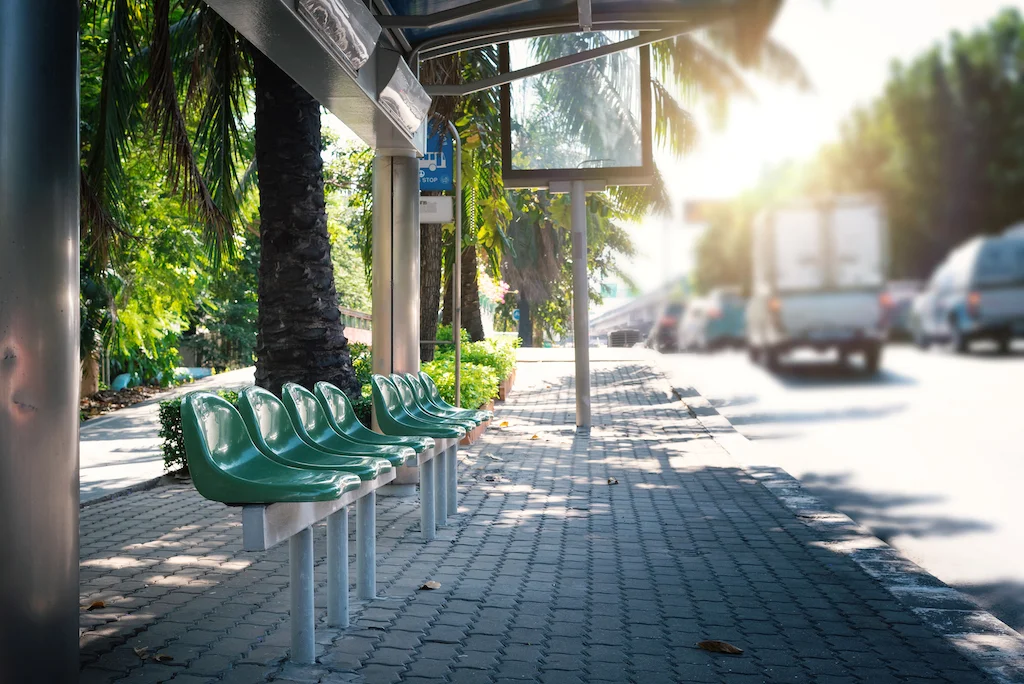
Public buses in Bangkok have extensive routes covering many areas in the city. Opting for public bus services in Bangkok is a cost-effective and efficient choice for city travel. These buses come in both non-air-conditioned and air-conditioned variants, depending on the route and passenger preferences.
To use the public bus service, wait at the bus stop. When the bus arrives, you can board and pay the fare directly on the bus; bus conductors will collect the fare. Currently, there is no integrated ticket system or advance purchase option for tourists. If you’re nearing your destination, simply press the stop button before reaching the bus stop. The bus driver will stop at the designated location, allowing you to alight immediately.
You can check bus routes on the website Bangkok Mass Transit Authority .
Important note: Due to heavy traffic in Bangkok, bus schedules are not always precise, so it’s advisable to allow extra travel time.
Boat
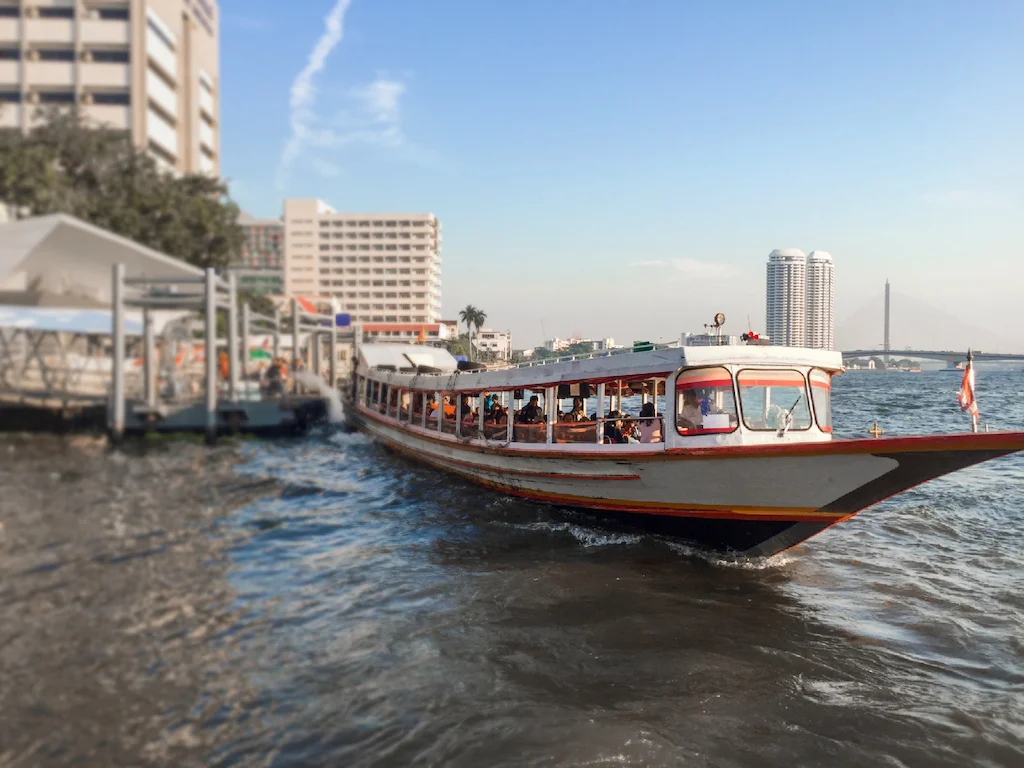
Bangkok, the vibrant capital of Thailand, boasts a major river known as the Chao Phraya.
This river flows through the heart of the city, dividing it into two distinct sides: the Phra Nakhon side to the east and the Thonburi side to the west.
Traveling by boat offers a fast and remarkably inexpensive way to get around Bangkok. These boats operate on regular routes, connecting various points along the river.
It’s a convenient way to explore Bangkok and take in the scenic views along the Chao Phraya River.
When using boats as transportation, fares are typically paid at the piers.
Depending on your journey, you may pay either at the starting pier or the destination pier.
Rapid Transit
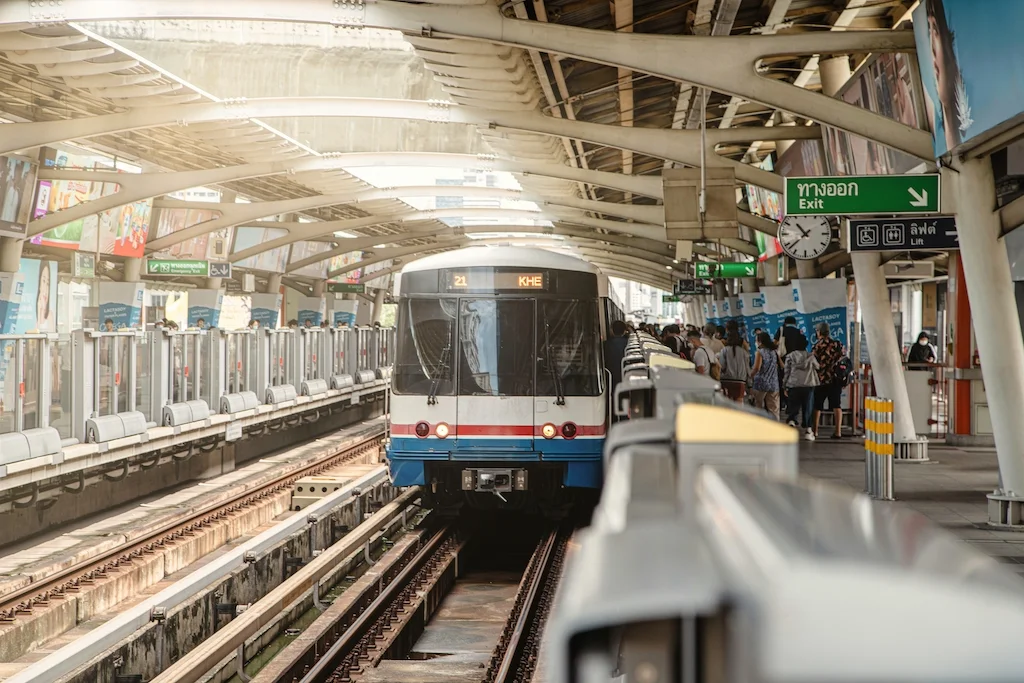
The rail system network in Bangkok allows convenient and fast travel to various parts of the city.
Whether you’re heading to the CBD, shopping districts, commercial areas, or tourist attractions, this network has you covered. Fares start at 15 baht and go up to a maximum of 62 baht per trip.
The primary rail system providers in Bangkok are as follows:
- BTS (Bangkok Mass Transit System) : Provides services on the Sukhumvit Line (green), Silom Line (dark green), and Gold Line.
- MRT (Metropolitan Rapid Transit) : Offers services on the Blue Line, Purple Line, Pink Line, and Yellow Line.
- ARL (Airport Rail Link): Connects the city with Don Mueang Airport.
- SRT (S.R.T. Red Line Mass Transit System) : Operates the Dark Red Line and Light Red Line.
Currently, there is no single card that allows you to use all four systems. You’ll need to purchase tickets based on the specific service provided by each operator. For more information, feel free to inquire at the ticket counters.
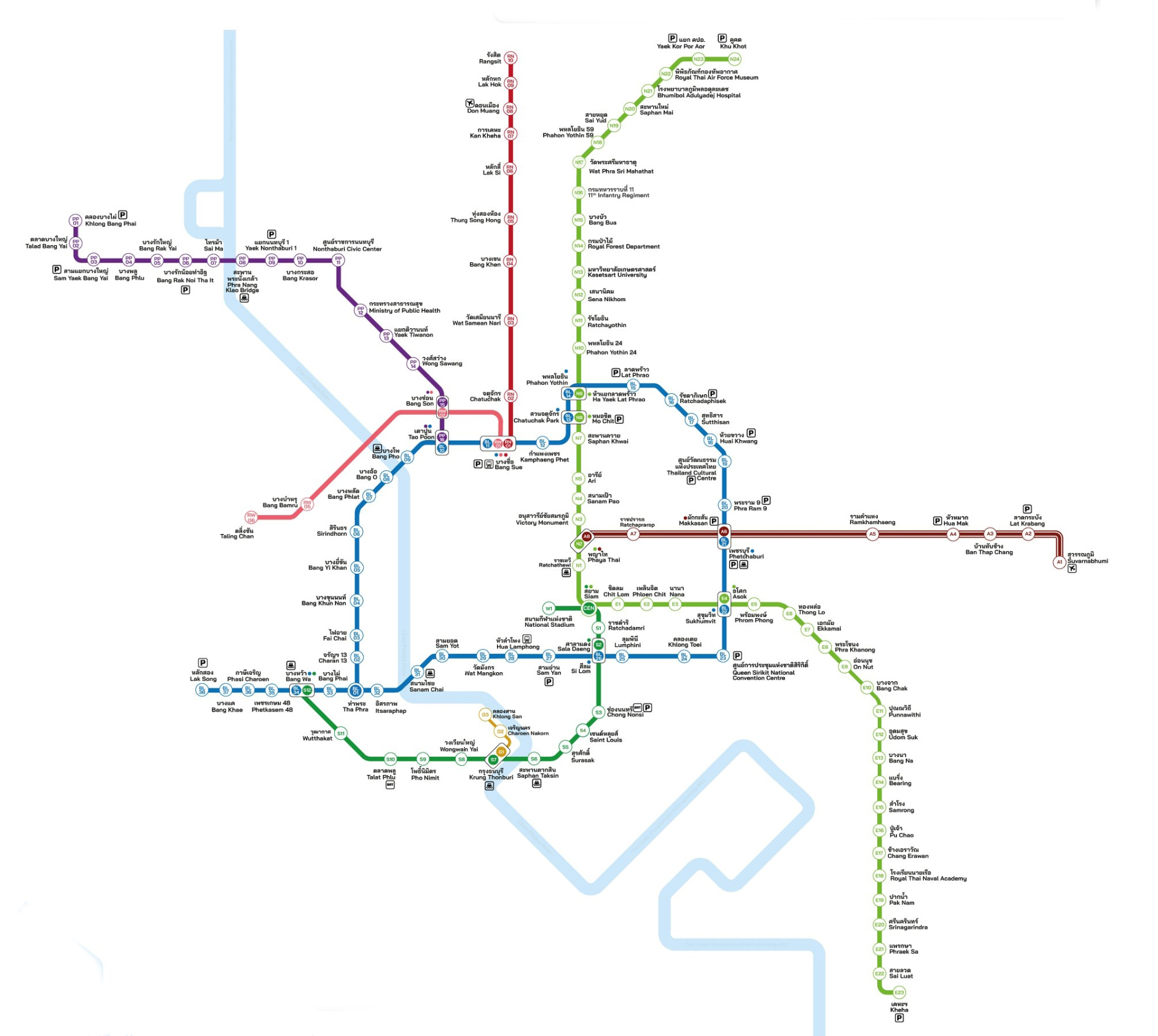
(Click on the image to view it in full size.)
Commuter Train
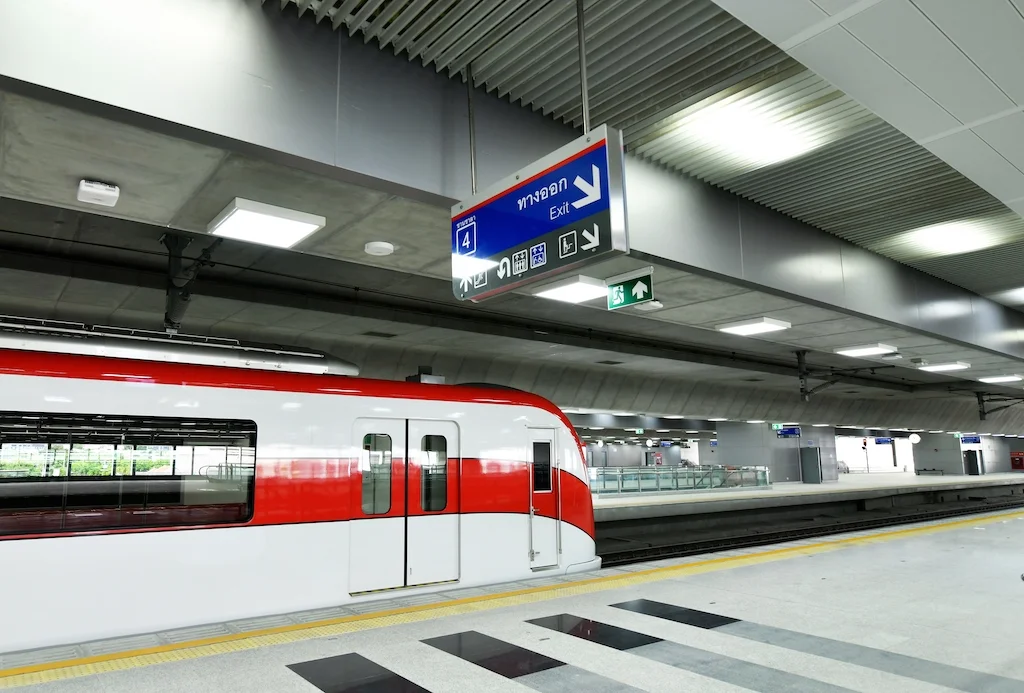
The commuter train service in Bangkok is operated by the State Railway of Thailand (SRT).
It provides services within the Bangkok metropolitan area and its suburbs. Commuter trains stop at every station and every designated stop along the routes.
The service covers the following lines:
- Northern Line: Connects Bangkok to Lopburi.
- Northeastern Line: Operates between Bangkok and Kaeng Khoi Junction.
- Eastern Line: Provides services between Bangkok and Chachoengsao Junction.
- Southern Line: Offers services from Thonburi to Nakhon Pathom and Thonburi to Prachuap Khiri Khan.
- Wongwian Yai Line: Serves the route from Wongwian Yai to Mahachai.
- Maeklong Line: Operates between Ban Laem and Maeklong.
When purchasing passenger tickets, buy them at the origin station. During your train journey, ticket inspectors will be present to verify tickets. For route information, you can visit the official website State Railway of Thailand.
Taxi
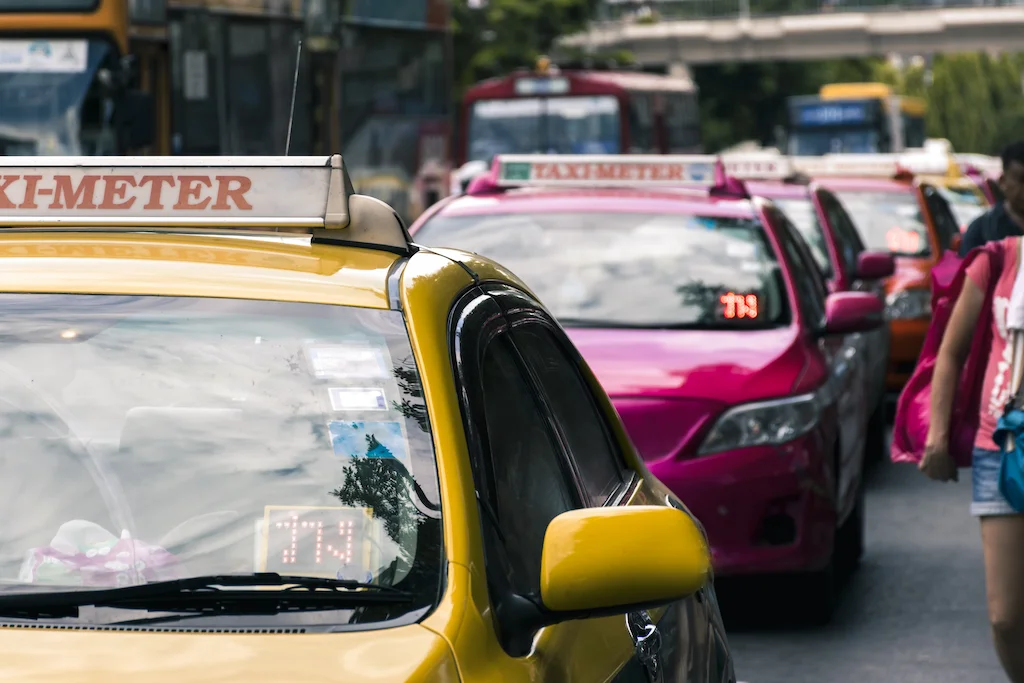
Traveling by taxi is quite convenient, and you can easily hail one on the streets as there is no specific taxi stand. You can immediately use the service when you see a taxi with the “available” light on (Thai: ว่าง). Taxis often have different colors from regular cars, such as green-yellow, yellow, pink, orange, green, which are just distinctions by the service provider and do not signify anything important. All providers charge the same rates and can take you anywhere.
The fare is calculated based on distance, starting at 40 baht, with incremental charges ranging from 6.50 to 9.00 baht, and up to 10.50 baht per kilometer for distances over 80 kilometers. If the taxi cannot move or drive more than 6 kilometers per hour, an additional 3.00 baht per minute is charged.
In addition to the fare, the passenger is responsible for the expressway toll fees. The driver may pay for these fees first and then collect them along with the fare.
The meter automatically calculates the fare, which is paid at the destination. However, if you call a taxi through a service center or from the airport, there may be additional charges.
Flat-rate fares are illegal, but it is common to see drivers charging flat rates, especially to foreigners.
Taxis in Thailand mostly use gas as fuel, such as LPG or CNG, for cost efficiency. Therefore, passengers should note that smoking is strictly prohibited while riding in a taxi for safety reasons, even if the driver allows it. Drivers may sometimes permit smoking in hopes of receiving a tip, but for your safety and the safety of others, it is best to avoid doing so.
Regarding tips, there is no requirement to give or the minimum tip to give (usually 10-20 baht). Tips are generally given as a gesture of appreciation for good service, politeness, and help with loading and unloading luggage, or from the change returned, as drivers often claim to have no change.
Remember to carry cash or coins to pay the exact fare.
Note : Using taxi services in Bangkok is quite safe, but you should remember the license plate number displayed on the car door for tracking in case of incidents or lost items during the ride.
Motorcycle Taxi
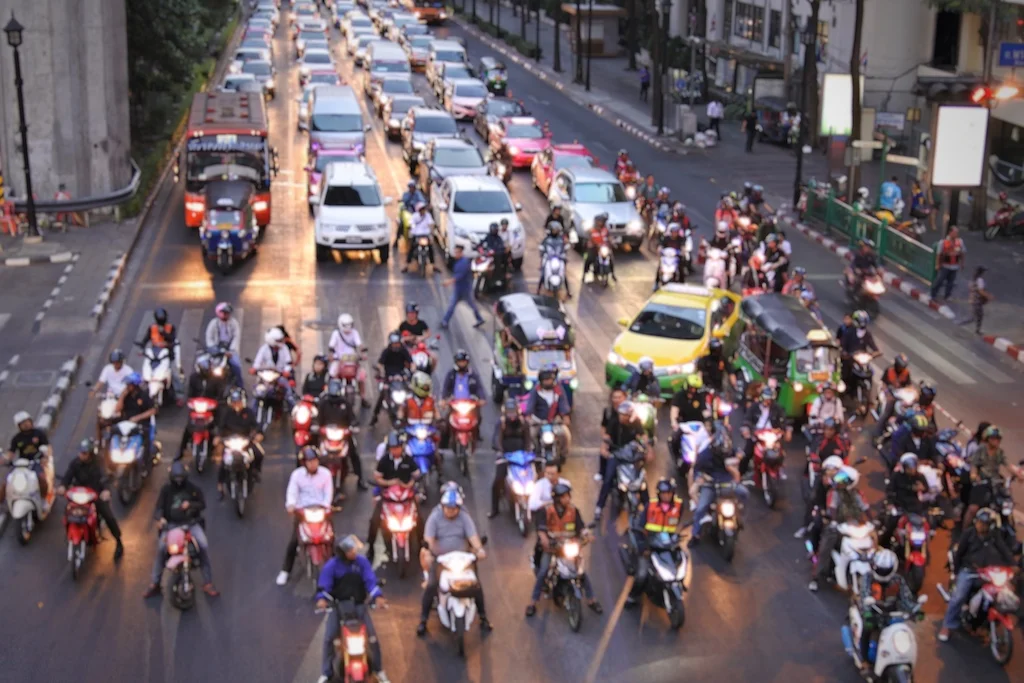
Traffic congestion in Bangkok can be an issue. If you are in a hurry or need to travel quickly, motorcycle taxis are another option that can get you to your destination fast. Motorcycle taxis are frequently accessible, and fares are normally displayed at designated stands. We recommend that you always inquire about the fee in advance, as motorcycle taxis do not have meters like taxis. The driver estimates the fee depending on the distance traveled, and it is typical to see drivers overcharging, particularly with foreign tourists.
Tuk Tuk
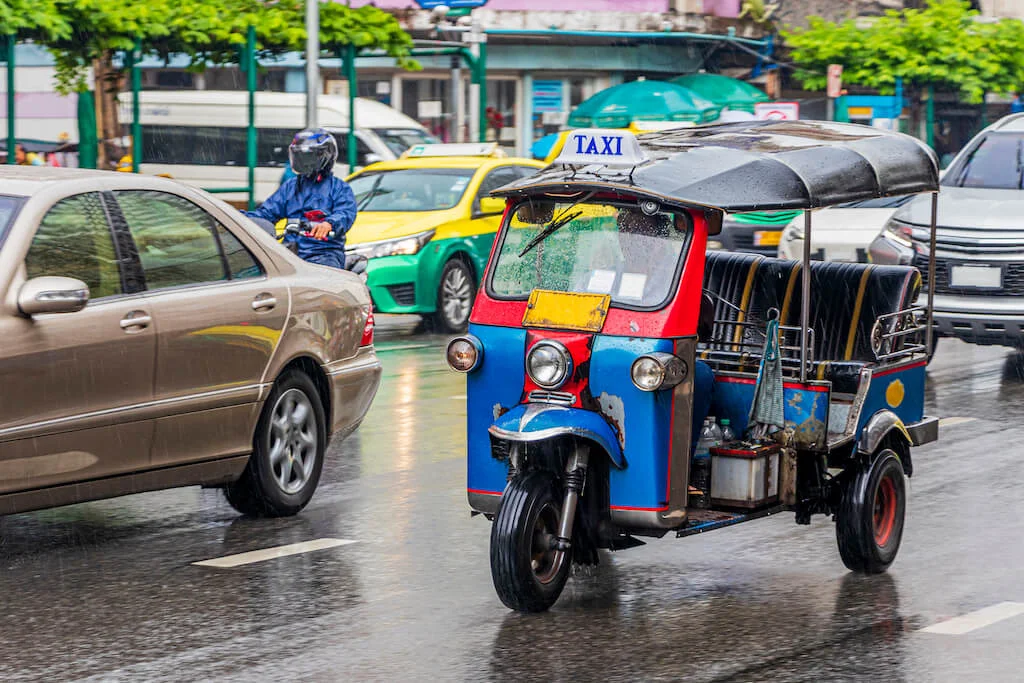
Another unique experience to try when traveling in Thailand is taking a ride on a tuk-tuk or a three-wheeled motorized taxi. These vehicles are commonly found near tourist attractions.To use a tuk-tuk, you can inform the driver of your destination, but always remember to negotiate the fare before getting in.
Unlike regular metered taxis, tuk-tuks don’t have meters, and the fare is usually estimated based on distance or the number of passengers. Be aware that sometimes tuk-tuk drivers may overcharge,
especially for foreign tourists.
For a more budget-friendly option, consider taking other types of public transportation after experiencing the tuk-tuk ride. You will notice that tuk-tuks are rarely used by locals.
Taxi App
Hailing a taxi on the street often leads to annoying issues such as drivers refusing service, flat-rate fares, and safety concerns. Therefore, using ride-hailing apps is a better alternative, offering services for cars, motorcycles, and VIP vans, except for tuk-tuks.
Popular apps in Thailand include:
- Grab: Highly popular for both food delivery and passenger transport.
- Line Man: User-friendly and convenient.
- Bolt: Cheaper rates than other apps and easy to use, but not as popular yet.
- CABB: The service provided by CABB’s own vehicles serves the same quality standards and is safe, with amenities throughout the journey.


